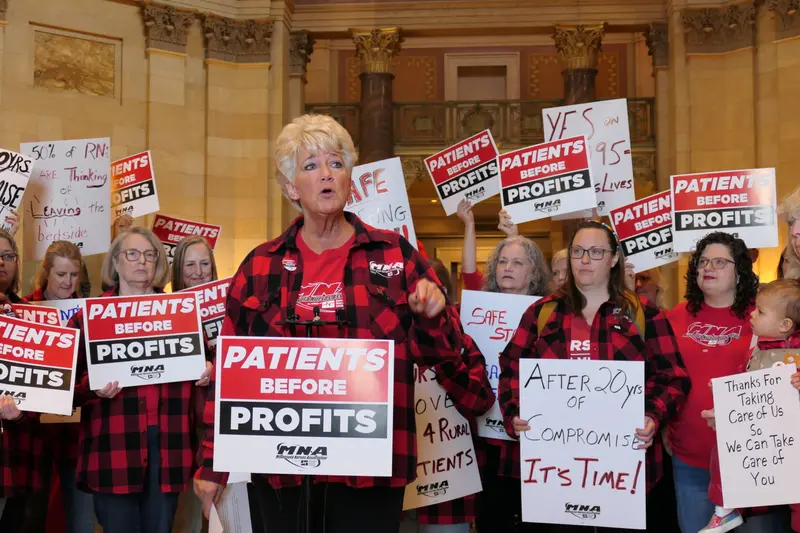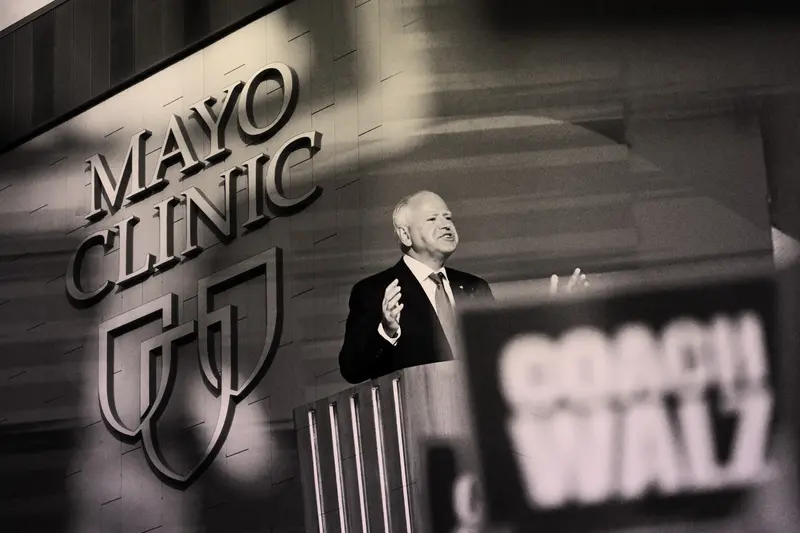Reporting Highlights
- A Close Relationship: Since the beginning of his political career, Gov. Tim Walz has maintained close ties to the world-famous Mayo Clinic in Rochester, Minnesota.
- Mayo’s Influence: The hospital had considerable sway with the Obama administration as it crafted the 2010 Affordable Care Act, and it lobbied against a public option.
- Limits of Power: Mayo convinced Walz to help kill bills by threatening to withhold billions in investments. When Walz pushed back on Mayo’s plans for consolidation, he had little success.
These highlights were written by the reporters and editors who worked on this story.
At the vice presidential debate against Republican Sen. JD Vance this month, Minnesota Gov. Tim Walz did something he’s done throughout his nearly 20-year career in politics: name-drop the Mayo Clinic.
“If you need heart surgery, listen to the people at the Mayo Clinic in Rochester, Minnesota, not Donald Trump,” Walz said.
Later in the debate, he did it again, after Vance criticized the Affordable Care Act, the 2010 law that expanded access to health coverage.
“I come from a major health care state, home of the Mayo Clinic,” said Walz. “We understand health care.”
Walz’s high regard for the world-renowned hospital system in southeastern Minnesota makes sense — he represented the Rochester area in Congress for 12 years, and it’s where he and his wife, Gwen, sought fertility treatment before having their daughter, Hope. The nonprofit Mayo is the state’s largest employer with more than 50,000 employees.
On various occasions, Walz has also acquiesced to the wishes of Mayo, even when those were at odds with the goals of other allies. In 2023, for example, Mayo leveraged its plans for a $5 billion expansion in Minnesota to muscle Walz into helping kill a bill aimed at slowing the speed of rising health care costs, which had passed the state House and Senate.
Years earlier, while still in Congress, Walz tried to push back against Mayo when it consolidated services after gobbling up local hospitals across southern Minnesota. When Mayo announced in 2017 that it intended to close labor and delivery, surgery and intensive care units in the city of Albert Lea, Walz supported workers protesting the reductions as a part of a contract fight with the hospital. But Mayo did not change course.
“He probably could have done more,” said Brad Arends, one of the leaders of a group in Albert Lea called Save Our Hospital that tried to preserve services. “Mayo was the bright shining star and now Mayo is literally a four-letter word in Albert Lea.”
“Mayo," he added, "has a way of hypnotizing people, especially probably politicians."

Mayo’s lobbying abilities extend beyond Walz and Minnesota’s borders. The hospital system has resisted proposals aimed at reining in the cost of health care, and has found success with Democrats in getting its way. Vice President Kamala Harris is running for president in part on lowering health care costs — it's listed third on her policy agenda — and her plan is built around expanding government subsidies and the Affordable Care Act.
When the ACA was first being debated, Mayo helped beat back an attempt to include a national public option, or an insurance plan run by the government. Today, the cost of care at Mayo is 88% higher than the state average, according to health care industry analysts at the nonprofit MN Community Measurement.
“Moderate Democrats, they haven’t been able to stand up to the hospital industry. That’s a pattern all over the country,” said Gillian Mason, the executive director of Healthcare NOW, which advocates for the creation of single-payer, federally managed universal healthcare coverage.
Kendall Witmer, the Minnesota senior communications adviser for the Harris-Walz campaign, said in a statement that Walz “has championed expanding access to affordable and high-quality healthcare, particularly for rural Minnesotans and veterans across the country.” She added that, under Walz, “Minnesota is recognized as a top 5 business state, a top 3 state to raise a child, and the best state for health care in the country.”
Andrea Kalmanovitz, director of communications for the Mayo Clinic, said its physicians treat “some of the most serious and complex medical conditions in the world.” The MN Community Measurement analysis that shows Mayo’s costs are higher than the state average does take into account how sick a hospital’s patients are.
“Mayo Clinic is guided in all we do by our primary value — the needs of the patient come first,” Kalmanovitz said in a statement. “As a nonprofit, we are strongly nonpartisan and work with policymakers to promote understanding of how policy proposals affect our patients and impact Mayo Clinic’s ability to fulfill its mission and further advance the transformation of healthcare.”
Walz siding with the Mayo Clinic reflects the deference he sometimes pays industry giants in Minnesota, a state that claims the fifth-most Fortune 500 companies per capita in the U.S. The headquarters of General Mills, U.S. Bancorp, 3M and Target are in Minnesota. UnitedHealth Group, the country’s largest health insurance company, and the food conglomerate Cargill, which is estimated to be the largest private company in the country, also have their headquarters in the state.
Larry Jacobs, director of the Center for the Study of Politics and Governance at the University of Minnesota, said the governor has demonstrated a willingness to water down progressive policies to appease big business.
“Is that caving or is that pragmatism?” asked Jacobs. “I think what you're seeing is how you govern the progressive way in the real world.”
During the 2023 Legislative session, the Minnesota Nurses Association felt confident that it could finally pass legislation requiring hospitals to increase nurse staffing levels after 15 years of losing that fight to the hospital lobby. The 2022 elections months earlier had handed Walz a second term as governor, and for the first time in a decade, voters also gave control of both the state Senate and House to Democrats. The Keeping Nurses at the Bedside Act seemed destined to become law after it sailed through the House and Senate.
But two and a half weeks before the end of the session, an email from a Mayo lobbyist landed in the inboxes of Walz’s most senior advisers and set off a panic. “Mayo has long been planning significant facilities and infrastructure investments in Minnesota,” the lobbyist, Kate Johansen, wrote. Without changes to the bill, she added, Mayo would need to take its “enormous investment to other states.”
Mayo was asking for a special exemption from the nurse staffing bill, and it said that it wanted a second bill, which would empower the state to penalize hospitals for raising prices faster than targets set by a newly created commission, scrapped entirely.
If the pressure on Walz wasn’t enough, Johansen also forwarded the message to the state’s top Democratic leaders stressing the urgency. “The decision to withdraw the planned investment described below is, unfortunately, time sensitive and will be resolved in the next few days,” she wrote.
According to Mary Turner, then president of the state nurses union, Walz reached out the next day. He told her he supported the nurses — he had walked a picket line with them months earlier during what was then the largest private sector nurses strike in U.S. history — but that Mayo doesn’t bluff.
Nurses organized a sit-in at the governor’s Capitol office, an effort they nicknamed “Occupy Walz Street.” Although Walz met with some of the nurses, by all accounts the Mayo ultimatum became the final word on the matter. After initially resisting, the bill’s authors drafted the exemption Mayo demanded in response to pressure from Walz.

Mayo said that all hospitals should be able to earn exemption from the law by using advanced staffing software, which Mayo said was more effective in determining staffing needs. But the bill’s authors rejected that proposal, choosing to only carve out Mayo. That upset other hospital leaders, who’d been lobbying against the bill for months. The measure then unraveled in the Senate.
Mayo has another leg up when it comes to influence: Mayo lobbyist Sarah Erickson, who’s with the firm United Strategies, was previously the operations director of Walz’s campaign for governor.
That close contact with the governor’s office can be in the public’s interest. The Mayo Clinic was instrumental in Walz’s response to the COVID-19 pandemic, providing regular updates and expertise on infection rates. It also helped roll out the COVID-19 vaccine.
What We’re Watching
During Donald Trump’s second presidency, ProPublica will focus on the areas most in need of scrutiny. Here are some of the issues our reporters will be watching — and how to get in touch with them securely.

Learn more about our reporting team. We will continue to share our areas of interest as the news develops.





If you don’t have a specific tip or story in mind, we could still use your help. Sign up to be a member of our federal worker source network to stay in touch.
We’re trying something new. Was it helpful?
Setting aside his relationship with Mayo, Walz’s record of standing up to big business is mixed. His sole veto in the 2023 Legislative session was for a bill setting minimum wages and labor standards for Uber and Lyft drivers, after Uber threatened to pull out of Minnesota entirely and set off fears that residents with disabilities and tourists would be left stranded. The following year he signed a compromise version of the bill with lower pay rates that Uber and Lyft ultimately agreed to.
He’s also drawn criticism from the state’s environmental community for not challenging permits issued for a proposed copper-nickel mine formerly known as PolyMet (now called NewRange Copper Nickel), owned by Glencore, one of the largest multinational corporations in the world, which pleaded guilty in 2022 to bribery and corruption charges brought by the U.S. government.
Uber, Lyft and Glencore declined to comment.
Walz signed one of the nation’s strictest bans on PFAS, the forever chemical born at 3M, although the company had already said it would “exit all PFAS manufacturing globally by the end of 2025.” He also signed another prohibiting for-profit health insurance companies from selling plans as a part of Minnesota’s Medicaid program. The only company affected was UnitedHealthcare, the health insurance arm of UnitedHealth Group, which sued the state over the law. That lawsuit is pending and the company said in a statement that it strongly believes “that Minnesotans deserve the right to choose among health plans that offer the broadest access to care, the most innovative services and the highest quality benefits to meet their health care needs.”
Walz’s relationship with Mayo, however, has potentially far-reaching implications for federal health care reform. Mayo was hugely influential on the Obama administration when the ACA was being drafted, arguing that the focus of new policy should be delivering more efficient care, not lowering prices. In the summer of 2009, Mayo Clinic leaders voiced strong opposition to the creation of a public option, which advocates say would have helped pull down the ballooning price of both health care treatments and insurance.
Rather than risk losing the hospital’s support, the Obama administration drew Mayo even closer into the process. “They said, ‘Tell us exactly what you want,’” Denis Cortese, Mayo’s CEO at the time, told the Washington Post. By the end of 2009, any plans for including a public option were dead.
In the roughly 15 years since the ACA was born, Mayo Clinic has demonstrated resistance to further efforts to rein in health care spending while stirring up repeated questions about its commitment to rural health care and serving poor patients.
Since 2017, Mayo has closed at least more than a dozen rural clinics and a hospital in southern Minnesota and northern Iowa, citing staffing issues. In 2017, the Star Tribune reported that then-CEO Dr. John Noseworthy told employees that patients with private insurance would be given preference over those with Medicaid or Medicare, which pay less for care than private plans.
The hospital has also sued low-income patients for medical debt even though they were eligible for free or discounted care, which nonprofit hospitals are required to offer under the ACA, according to an investigation by the Rochester Post Bulletin. In response, Minnesota lawmakers passed a bill requiring hospitals to screen patients for eligibility for financial assistance before pursuing collections, which Walz signed.
Mayo Clinic's higher costs don’t just affect its patients. The hospital’s significant market share and high prices have contributed to a higher cost of living for families without employer-funded insurance in the Rochester area than in the Twin Cities, even though housing, food and other necessities are cheaper, according to the nonprofit economic think tank Economic Policy Institute’s family budget calculator.
That’s true even for healthy residents who rarely see their doctor, because insurance premiums for individual plans are higher in the Rochester area, which is about 90 miles from St. Paul and Minneapolis. Southeastern Minnesota has the highest average premiums for individual insurance plans in the state, with residents paying nearly 60% more before subsidies than people living in the Twin Cities metro area, according to data from MNsure.
Arends, now the president of the nonprofit Albert Lea Healthcare Coalition, said he would like to see politicians from both parties spend more time pressuring Mayo to lower their costs. “All of them — not just Tim Walz,” he said.
In response to questions about the higher cost of health care plans in southern Minnesota, Kalmanovitz wrote that the premium costs are beyond Mayo’s control. “Providers do not have any input into this process.” She said Mayo has a “robust” financial assistance program that patients can apply for online.
Whether a Harris-Walz administration would try to enact the kind of aggressive cost-saving reforms that Mayo might oppose remains to be seen. While Walz supports a state public option in Minnesota, Harris has backed off of previous support for a federal single-payer system such as Medicare for all. Instead, the campaign has pledged to renew the tax credits that President Joe Biden enacted to lower insurance premium payments, which are set to expire after 2025.
“Vice President Harris’s plans will make prescription drugs less expensive, expand access to health care, reduce medical debt, and continue strengthening the Affordable Care Act, while Donald Trump’s ‘concept’ of a health care plan will raise costs and remove peace of mind for millions of Americans,” Witmer, the campaign spokesperson, said in a statement.
Absent from Harris’ plan, however, is any mention of lowering hospital rates.
Larry Levitt, executive vice president for health policy at the nonprofit KFF, adds that Democrats forged bonds with the hospital industry to beat back nearly 15 years’ worth of efforts by Republicans to repeal the ACA.
“Democrats and hospitals have fought side by side during the battles over the ACA,” he said. “I'm sure that goodwill will help the industry in the future.”
In November 2023, Walz attended Mayo Clinic’s unveiling of its $5 billion expansion, a project that CEO Dr. Gianrico Farrugia called a once-in-three-generations opportunity to “redefine the future of health care.”
“There is no more important place on the planet and no more important work being done for humanity than is being done in this spot in Rochester, Minnesota,” Walz said at the event.
Turner, the former Minnesota nurses union leader who is now a president of National Nurses United, anticipates that what was once a local political fight for Walz will travel with him to a national stage should he and Harris take the White House.
“The bean counters are running health care right now. And they're trying to run it, and I've said this before, they're trying to run it like it's a frickin’ factory,” she said. “Once it gets to the federal level, if it isn't Mayo that's going to try to influence it, it's going to be Kaiser or Sutter, or any other huge, huge health care operation.”











